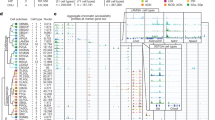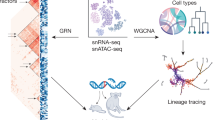Abstract
Neurogenomics is the study of how the genome as a whole contributes to the evolution, development, structure and function of the nervous system. It includes investigations of how genome products (transcriptomes and proteomes) vary in time and space. Neurogenomics differs markedly from the application of genome sciences to other systems, particularly in the spatial category, because anatomy and connectivity are paramount to our understanding of function in the nervous system. We focus here on some of the influences of genomics and its associated technologies on neuroscience. We discuss comparative genomics, gene expression atlases of the brain, network genetics and applications to behavioral phenotypes, and consider the culture, organization and funding of genome-scale projects.
This is a preview of subscription content, access via your institution
Access options
Subscribe to this journal
Receive 12 print issues and online access
$209.00 per year
only $17.42 per issue
Buy this article
- Purchase on Springer Link
- Instant access to full article PDF
Prices may be subject to local taxes which are calculated during checkout
Similar content being viewed by others
References
Tilghman, S.M. Lessons learned, promises kept: a biologist's eye view of the Genome Project. Genome Res. 6, 773–780 (1996).
Boguski, M.S., Lowe, T.M. & Tolstoshev, C.M. dbEST—database for “expressed sequence tags”. Nat. Genet. 4, 332–333 (1993).
Schuler, G.D. et al. A gene map of the human genome. Science 274, 540–546 (1996).
Lander, E.S. et al. Initial sequencing and analysis of the human genome. Nature 409, 860–921 (2001).
Jessell, T. & Kandel, E. Introduction: one decade of Neuron, six decades of neuroscience. Neuron 20, 367–369 (1998).
Tecott, L.H. The genes and brains of mice and men. Am. J. Psychiatry 160, 646–656 (2003).
Boguski, M.S. Comparative genomics: the mouse that roared. Nature 420, 515–516 (2002).
Enard, W. et al. Molecular evolution of FOXP2, a gene involved in speech and language. Nature 418, 869–872 (2002).
Clark, A.G. et al. Inferring nonneutral evolution from human-chimp-mouse orthologous gene trios. Science 302, 1960–1963 (2003).
Boguski, M.S. The only thing permanent is change. Genomics 82, 253 (2003).
Sanger, F. & Coulson, A.R. A rapid method for determining sequences in DNA by primed synthesis with DNA polymerase. J. Mol. Biol. 94, 441–448 (1975).
Hieter, P. & Boguski, M. Functional genomics: it's all how you read it. Science 278, 601–602 (1997).
Liang, M., Cowley, A.W. & Greene, A.S. High throughput gene expression profiling: a molecular approach to integrative physiology. J. Physiol. (Lond.) 554, 22–30 (2004).
Boguski, M.S. Biosequence exegesis. Science 286, 453–455 (1999).
Kell, D.B. & Oliver, S.G. Here is the evidence, now what is the hypothesis? The complementary roles of inductive and hypothesis-driven science in the post-genomic era. Bioessays 26, 99–105 (2004).
Adams, M.D. et al. Complementary DNA sequencing: expressed sequence tags and human genome project. Science 252, 1651–1656 (1991).
Zweiger, G. Transducing the Genome: Information, Anarchy, and Revolution in the Biomedical Sciences (McGraw-Hill, New York, 2001).
Adams, M.D. et al. Sequence identification of 2,375 human brain genes. Nature 355, 632–634 (1992).
Boguski, M.S. & Schuler, G.D. ESTablishing a human transcript map. Nat. Genet. 10, 369–371 (1995).
Ermolaeva, O. et al. Data management and analysis for gene expression arrays. Nat. Genet. 20, 19–23 (1998).
Mathe, C., Sagot, M.F., Schiex, T. & Rouze, P. Current methods of gene prediction, their strengths and weaknesses. Nucleic Acids Res. 30, 4103–4117 (2002).
Picoult-Newberg, L. et al. Mining SNPs from EST databases. Genome Res. 9, 167–174 (1999).
Gu, Z., Hillier, L. & Kwok, P.Y. Single nucleotide polymorphism hunting in cyberspace. Hum. Mutat. 12, 221–225 (1998).
Boguski, M.S. Hunting for genes in computer data bases. N. Engl. J. Med. 333, 645–647 (1995).
Duyk, G.M. Sharper tools and simpler methods. Nat. Genet. 32 (Suppl.), 465–468 (2002).
Anonymous. Taking stock. Nat. Genet. 32, 461 (2002).
Kohane, I.S., Kho, A.T. & Butte, A.J. Microarrays for an Integrative Genomics (MIT Press, Cambridge, Massachusetts, USA, 2003).
Boguski, M.S. & McIntosh, M.W. Biomedical informatics for proteomics. Nature 422, 233–237 (2003).
Mirnics, K. & Pevsner, J. Progress in the use of microarray technology to study the neurobiology of disease. Nat. Neurosci. 434–439 (2004).
Bassett, D.E., Jr et al. Comparative genomics, genome cross-referencing and XREFdb. Trends Genet. 11, 372–373 (1995).
Tugendreich, S., Bassett, D.E., Jr., McKusick, V.A., Boguski, M.S. & Hieter, P. Genes conserved in yeast and humans. Hum. Mol. Genet. 3 (Spec. No.), 1509–1517 (1994).
Shoemaker, D.D. et al. Experimental annotation of the human genome using microarray technology. Nature 409, 922–927 (2001).
Velculescu, V.E. et al. Characterization of the yeast transcriptome. Cell 88, 243–251 (1997).
Velculescu, V.E., Zhang, L., Vogelstein, B. & Kinzler, K.W. Serial analysis of gene expression. Science 270, 484–487 (1995).
Bantle, J.A. & Hahn, W.E. Complexity and characterization of polyadenylated RNA in the mouse brain. Cell 8, 139–150 (1976).
Chikaraishi, D.M. Complexity of cytoplasmic polyadenylated and nonpolyadenylated rat brain ribonucleic acids. Biochemistry 18, 3249–3256 (1979).
Sutcliffe, J.G. mRNA in the mammalian central nervous system. Annu. Rev. Neurosci. 11, 157–198 (1988).
Blackshaw, S., Fraioli, R.E., Furukawa, T. & Cepko, C.L. Comprehensive analysis of photoreceptor gene expression and the identification of candidate retinal disease genes. Cell 107, 579–589 (2001).
Tietjen, I. et al. Single-cell transcriptional analysis of neuronal progenitors. Neuron 38, 161–175 (2003).
Carson, J.P., Thaller, C. & Eichele, G. A transcriptome atlas of the mouse brain at cellular resolution. Curr. Opin. Neurobiol. 12, 562–565 (2002).
Gong, S. et al. A gene expression atlas of the central nervous system based on bacterial artificial chromosomes. Nature 425, 917–925 (2003).
Singh, R.P. et al. High-resolution voxelation mapping of human and rodent brain gene expression. J. Neurosci. Methods 125, 93–101 (2003).
Cowan, W.M. The emergence of modern neuroanatomy and developmental neurobiology. Neuron 20, 413–426 (1998).
Lockhart, D.J. & Barlow, C. Expressing what's on your mind: DNA arrays and the brain. Nat. Rev. Neurosci. 2, 63–68 (2001).
Anonymous. Mapping the mouse brain. Nat. Neurosci. 6, 1113 (2003).
Valenzuela, D.M. et al. High-throughput engineering of the mouse genome coupled with high-resolution expression analysis. Nat. Biotechnol. 21, 652–659 (2003).
Schadt, E.E., Monks, S.A. & Friend, S.H. A new paradigm for drug discovery: integrating clinical, genetic, genomic and molecular phenotype data to identify drug targets. Biochem. Soc. Trans. 31, 437–443 (2003).
Chesler, E.J. et al. Genetic correlates of gene expression in recombinant inbred strains: a relational model system to explore neurobehavioral phenotypes. Neuroinformatics 1, 343–357 (2003).
Tecott, L.H. & Nestler, E.J. Neurobehavioral assessment in the information age. Nat. Neurosci. 462–466 (2004).
Nass, S.J. & Stillman, B. National Cancer Policy Board (U.S.). Committee on Large-scale Science and Cancer Research. & National Research Council (U.S.). Division on Earth and Life Studies. Large-Scale Biomedical Science: Exploring Strategies for Future Research (National Academies Press, Washington, DC, USA, 2003).
Winslow, R.L. & Boguski, M.S. Genome informatics: current status and future prospects. Circ. Res. 92, 953–961 (2003).
Moldin, S.O., Farmer, M.E., Chin, H.R. & Battey, J.F., Jr. Trans-NIH neuroscience initiatives on mouse phenotyping and mutagenesis. Mamm. Genome 12, 575–581 (2001).
International HapMap Consortium. The International HapMap Project. Nature 426, 789–796 (2003).
Holden, A.L. The SNP consortium: summary of a private consortium effort to develop an applied map of the human genome. Biotechniques 26 (Suppl.), 22–24 (2002).
Anonymous. Merck releases first 'gene index' sequences. Nature 373, 549 (1995).
Williamson, A.R. The Merck Gene Index project. Drug Discov. Today 4, 115–122 (1999).
Insel, T.R., Volkow, N.D., Li, T.K., Battey, J.F. & Landis, S.C. Neuroscience networks: data-sharing in an information age. PLoS Biol 1, E17 (2003).
Martone, M.E., Gupta, A. & Ellisman, M.H. e-Neuroscience: challenges and triumphs in integrating distributed data from molecules to brains. Nat. Neurosci. 467–472 (2004).
Van Horn, J.D., Grafton, S.T., Rockmore, D. & Gazzaniga, M.S. Sharing neuroimaging studies of human cognition. Nat. Neurosci. 473–481 (2004).
Koslow, S.H. Sharing primary data: a threat or asset to discovery? Nat. Rev. Neurosci. 3, 311–313 (2002).
Zerhouni, E. The NIH Roadmap. Science 302, 63–72 (2003).
Neuhauss, S.C. Behavioral genetic approaches to visual system development and function in zebrafish. J. Neurobiol. 54, 148–160 (2003).
Marcus, G.F. The Birth of the Mind: How a Tiny Number of Genes Creates the Complexities of Human Thought (Basic Books, New York, 2004).
White, J., Southgate, E., Thomson, J. & Brenner, S. The structure of the nervous system of the nematode Caenorhabditis elegans . Phil. Trans. R. Soc. Lond. B Biol. Sci. 314, 1–340 (1986).
Acknowledgements
We thank N. Beauchamp, S. Minoshima and R. Williams for critical readings of the manuscript.
Author information
Authors and Affiliations
Corresponding author
Ethics declarations
Competing interests
The authors declare no competing financial interests.
Rights and permissions
About this article
Cite this article
Boguski, M., Jones, A. Neurogenomics: at the intersection of neurobiology and genome sciences. Nat Neurosci 7, 429–433 (2004). https://doi.org/10.1038/nn1232
Published:
Issue Date:
DOI: https://doi.org/10.1038/nn1232
This article is cited by
-
A recap on Italian neurolaw: epistemological and ethical issues
Mind & Society (2017)
-
Analysis of multiplex gene expression maps obtained by voxelation
BMC Bioinformatics (2009)
-
Domain-Specific Data Sharing in Neuroscience: What Do We Have to Learn from Each Other?
Neuroinformatics (2008)
-
Statistical analysis of genomic protein family and domain controlled annotations for functional investigation of classified gene lists
BMC Bioinformatics (2007)
-
Study of gene function based on spatial co-expression in a high-resolution mouse brain atlas
BMC Systems Biology (2007)



